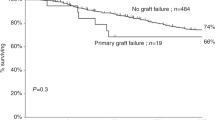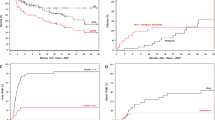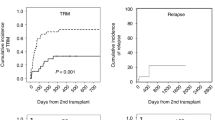Abstract
Following initial graft rejection, a second attempt at allogeneic immunotherapy is often contemplated, but data on the success is limited. We therefore report on 11 patients with hematologic malignancies, renal cell cancer or marrow failure who underwent a second reduced-intensity regimen for primary or secondary graft failure. Nine of the 11 patients initially engrafted with the second attempt including two of four who used the same donor. One of the patients engrafted after the third attempt using a different donor and conditioning regimen. There were two treatment-related deaths. Four patients died from progressive disease 1–9 months after the second transplant. Two patients are still in recovery phase less than 1 year from the second transplant. Long-term remission is possible and three patients are alive in complete remission.
This is a preview of subscription content, access via your institution
Access options
Subscribe to this journal
Receive 12 print issues and online access
$259.00 per year
only $21.58 per issue
Buy this article
- Purchase on Springer Link
- Instant access to full article PDF
Prices may be subject to local taxes which are calculated during checkout

Similar content being viewed by others
References
McSweeney P, Niederwieser D, Shizuru J, Sandmaier B, Molina A, Maloney D et al. Hematopoietic cell transplantation in older patients with hematologic malignancies: replacing high-dose cytotoxic therapy with graft-versus-tumor effects. Blood 2001; 97: 3390–3400.
Barrett AJ, Savani BN . Stem cell transplantation with reduced-intensity conditioning regimens: a review of ten years experience with new transplant concepts and new therapeutic agents. Leukemia 2006; 20: 1661–1672.
Narimatsu H, Kami M, Miyakoshi S, Murashige N, Yuji K, Hamaki T et al. Graft failure following reduced-intensity cord blood transplantation for adult patients. Br J Haematol 2006; 132: 36–41.
Champlin R, Khouri I, Shimoni A, Gajewski J, Kornblau S, Molldrem J et al. Harnessing graft-versus-malignancy: non-myeloablative preparative regimens for allogeneic haematopoietic transplantation, an evolving strategy for adoptive immunotherapy. Br J Haematol 2000; 111: 18–29.
Rizzieri DA, Koh LP, Long GD, Gasparetto C, Sullivan KM, Horwitz M et al. Partially matched, nonmyeloablative allogeneic transplantation: clinical outcomes and immune reconstitution. J Clin Oncol 2007; 25: 690–697.
Rizzieri DA, Koh LP, Long GD, Gasparetto C, Gong JZ, Lagoo A et al. Outcome and immune reconstitution following T cell depleted nonmyeloablative allogeneic transplantation using matched donors. Blood 2005; 106 (suppl): 2036, Abstract.
Laughlin M, Barker J, Bambach B, Koc ON, Rizzieri DA, Wagner JE et al. Hematopoietic engraftment and survival in adult recipients of umbilical-cord blood from unrelated donors. N Engl J Med 2001; 344: 1815–1822.
Fielding A, Richards SM, Chopra R, Lazarus HM, Litzow MR, Buck G et al. Outcome of 609 adults after relapse of acute lymphoblastic leukemia (ALL); an MRC UKALL12/ECOG 2993 study. Blood 2007; 109: 944–950.
Cheson BD, Pfistner B, Juweid ME, Gascoyne RD, Specht L, Horning SJ et al. Revised response criteria for malignant lymphoma. J Clin Oncol 2007; 25: 579–586.
Quinones RR . Hematopoietic engraftment and graft failure after bone marrow transplantation. Am J Pediatr Hematol Oncol 1993; 15: 3–17.
Anasetti C, Amos D, Beatty PG, Appelbaum FR, Bensinger W, Buckner CD et al. Effect of HLA compatibility on engraftment of bone marrow transplants in patients with leukemia or lymphoma. N Engl J Med 1989; 320: 197–204.
Bunjes D, Heit W, Arnold R, Schmeiser T, Wiesneth M, Carbonell F et al. Evidence for the involvement of host-derived OKT8-positive T cells in the rejection of T-depleted, HLA-identical bone marrow grafts. Transplantation 1987; 43: 501–505.
Walshe J, Bishop MR . Factors affecting engraftment of allogeneic hematopoietic stem cells after reduced-intensity conditioning. Cytotherapy 2004; 6: 589–602.
Storb R, Thomas ED, Buckner CD, Appelbaum FR, Clift RA, Deeg HJ et al. Marrow transplantation for aplastic anemia. Semin Hematol 1984; 21: 27–35.
Bishop MR, Steinberg SM, Gress RE, Hardy NM, Marchigiani D, Kasten-Sportes C et al. Targeted pretransplant host lymphocyte depletion prior to T-cell depleted reduced-intensity allogeneic stem cell transplantation. Br J Haematol 2004; 126: 837–843.
Baron F, Sandmaier BM . Chimerism and outcomes after allogeneic hematopoietic cell transplantation following nonmyeloablative conditioning. Leukemia 2006; 20: 1690–1700.
Hows JM . Mechanisms of graft failure after human marrow transplantation: a review. Immunol Lett 1991; 29: 77–80.
Ruiz-Arguelles GJ, Gomez-Almaguer D, Tarin-Arzaga LD, Morales-Toquero A, Cantu-Rodriguez OG, Manzano C . Second allogeneic peripheral blood stem cell transplants with reduced-intensity conditioning. Rev Invest Clin 2006; 58: 34–38.
Author information
Authors and Affiliations
Corresponding author
Rights and permissions
About this article
Cite this article
Byrne, B., Horwitz, M., Long, G. et al. Outcomes of a second non-myeloablative allogeneic stem cell transplantation following graft rejection. Bone Marrow Transplant 41, 39–43 (2008). https://doi.org/10.1038/sj.bmt.1705882
Received:
Revised:
Accepted:
Published:
Issue Date:
DOI: https://doi.org/10.1038/sj.bmt.1705882
Keywords
This article is cited by
-
Non-myeloablative conditioning for second hematopoietic cell transplantation for graft failure in patients with non-malignant disorders: a prospective study and review of the literature
Bone Marrow Transplantation (2017)
-
Salvage haploidentical transplantation for graft failure using reduced-intensity conditioning
Bone Marrow Transplantation (2012)
-
Outcomes of a 1-day nonmyeloablative salvage regimen for patients with primary graft failure after allogeneic hematopoietic cell transplantation
Bone Marrow Transplantation (2012)
-
Mycophenolate mofetil: fully utilizing its benefits for GvHD prophylaxis
International Journal of Hematology (2012)
-
Second allo-SCT from a different donor can improve severe steroid-resistant gut GVHD
Bone Marrow Transplantation (2010)



